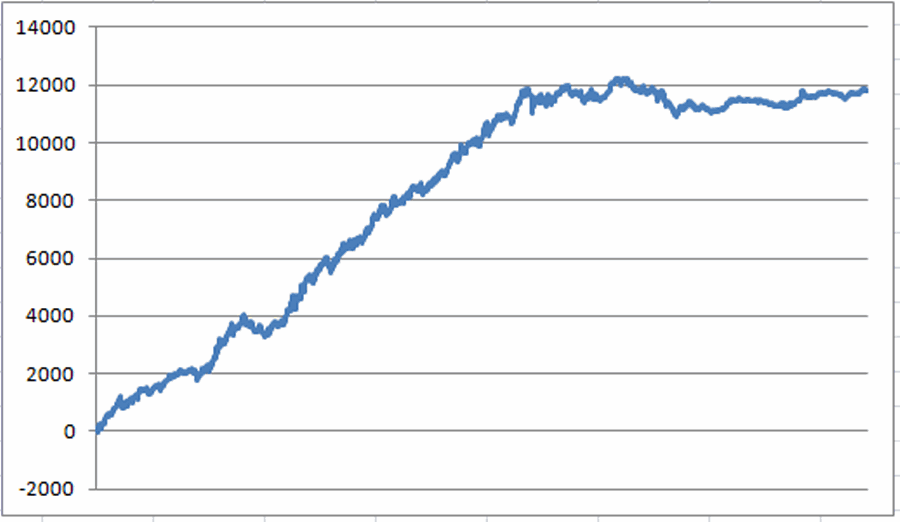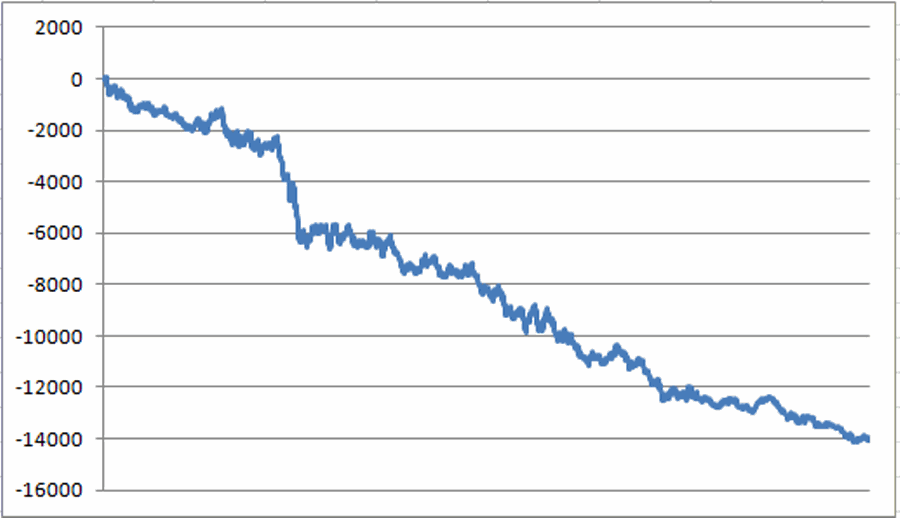“Everybody knows” that trying to pick the exact bottom in anything is stupid. I mean what are the odds that you’ll actually get it right? Still, human nature is a pesky thing, no?. So who is willing to call “the bottom” in gold and gold stocks?
(Jay Kaeppel Interview at BetterSystemTrader.com)
Well, not me necessarily. Of course, I’ve never been very good at predictions in the first place. Back in the early days I must admit I thought I could stare into my crystal ball of indicators/oscillators/chart patterns/etc and see what was coming next. Alas, I stared into that damn thing for a long time before I realized that it wasn’t actually working.
Still – as just another victim of that aforementioned “human nature” – I “feel the urge” once in awhile. Now if you are like me (and like most other traders) when you get the urge to pick a bottom (or top) you get the one voice on one shoulder saying “Go for it! Bet the ranch! Make a killing!” And the voice on the other shoulder that says, “You know better than to do something so foolish. Besides that trick never works.”
Here’s what I have found (and recommend) as a compromise to the voice in my, er, your head. Allocate up to (but no more than) 10% of your investment capital to “Speculation/Hedging”. You get the urge to “take a shot”. By all means, go ahead. But don’t risk more than a small portion of your investment capital. If it turns out that you are actually pretty good at “taking a shot” the big payoffs on your small bets can add up to a lot of money over time. And if the voice on the other shoulder is right, well, hey you’ve allowed yourself some discretion, you took your shot (granted you failed) but hey, it didn’t really hurt you financially.
So how about the gold market?
Here is my “analysis” of gold:
As you can see in Figure 1, my Anti-Gold Index remains in an undeniable uptrend. As this is an inverse indicator, this trend is bearish for gold. So make no mistake that what we are about to discuss is a “counter trend” trade is every sense of the word. Figure 1 – Jay’s Anti-Gold Index versus ticker GLD (Courtesy: AIQ TradingExpert)
Figure 1 – Jay’s Anti-Gold Index versus ticker GLD (Courtesy: AIQ TradingExpert)
Gold broke out to the downside on 11/17 and 11/18 but then closed back above the downside breakout point on 11/19 as you can see in Figure 2. Technical theory suggests that this could ultimately prove to mark an important double bottom (Well it could).
 Figure 2 – A false breakdown and bullish reversal for GLD??? (Courtesy: www.ProfitSource.com)
Figure 2 – A false breakdown and bullish reversal for GLD??? (Courtesy: www.ProfitSource.com)
So is this the bottom? I have to go with my standard answer here – “It beats the heck out of me.” But I am not so much interest in “the bottom” as I am interested in “a bottom” (i.e., one that holds for at least 29 calendar days for reasons we will get to in a moment) But someone might think so. So let’s highlight one possible way to play.
Switching to Gold Stocks
In Figure 3 we see ticker GDX, an ETF that tracks gold mining stocks rather than gold bullion. Gold stocks did not break down below support and have spent the better part of four months trying to build a base. Figure 3 – Ticker GDX; Gold stocks forming a base (Courtesy: AIQ TradingExpert)
Figure 3 – Ticker GDX; Gold stocks forming a base (Courtesy: AIQ TradingExpert)
If nothing else we can identify the price of $12.62 a share as the “line in the sand” for ticker GDX. Believe it or not, this simple designation opens the way to a potential option trade.
One Way to Play
OK, first the CYA disclaimers: I am not saying that gold stocks have bottomed. I am not telling you that you should think gold stocks have bottomed. I am not “recommending” that you make the trade I am about to highlight. The purpose of this example is simply to highlight one way to use options to speculate on a position that can make money if the security in question remains above an objectively identified “line in the sand” ($12.62 on GDX in this instance). OK, backside sufficiently covered, let’s move on.
The overarching “theme” for this trade is that everything hinges on GDX remaining above $12.62 a share. If that price is broken to the downside then the premise for making this trade evaporates and defensive action is in order. We are not even forecasting that GDX is going to rise substantially in price. So we want a position that will make money so long as GDX holds above our “line in the sand.”
First let’s assume that a trader has a $50,000 account, is willing to commit 8% to a single trade, and is willing to speculate that GDX will hold above $12.62 through December option expiration (12/18/15).
The bull put spread trade displayed in Figures 4 and 5:
*Sells 46 December 12.5 puts
*Buys 46 December 11.5 puts
*Has a maximum profit potential of $598
*This represents a maximum profit % of 14.98% on risk capital and 1.2% of total capital
*The maximum risk is -$4,002 (we will look at reducing this risk in a moment by adding a stop-loss point)
*With GDX at $13.97 the breakeven price on the trade is $12.37. So essentially, this trade will show a profit if GDX does anything besides fall -11.5% over the next 29 days.
 Figure 4 – GDX Dec 12.5/11.5 Bull put spread (Courtesy www.OptionsAnalysis.com)
Figure 4 – GDX Dec 12.5/11.5 Bull put spread (Courtesy www.OptionsAnalysis.com) Figure 5 – Risk Curves for GDX Dec 12.5/11.5 Bull put spread (Courtesy www.OptionsAnalysis.com)
Figure 5 – Risk Curves for GDX Dec 12.5/11.5 Bull put spread (Courtesy www.OptionsAnalysis.com)
For a trader putting on this trade (and again I am not recommending that you do, only that you use this example to learn what factors are most important in managing a trade such as this – hey, we take CYA seriously here at JayOnTheMarkets.com), the first and foremost decision is “where to place a stop-loss?” There are two possibilities that make sense:
*At some price below the recent low of $12.62: This makes sense because as I stated earlier, once 12.62 is broken the rationale for being in the trade is essentially gone.
*At or below the actual breakeven price of $12.37. This makes sense because the reality of this trade is that GDX can take out its low of 12.62 and still generate a profit.
Another piece of good advice I got a long time ago: Upon entering a trade ask yourself “what is the worst case scenario, what will I do if it happens and can I handle the loss?”
*In this case, the worst case is if immediately after this trade is entered GDX plummets to the $12.37. In this case the trader would be confronted with an open loss of approximately -$1,145 (note where the two red lines connect in Figure 5). So a trader is essentially risking roughly $1,145 to make roughly $600.
*As you can see in Figure 5, the risk curves move to the right which highlights the fact that as time goes by time decay begins to work in our favor.
*Once the trade is entered and a stop-loss point is selected the thing to do is “nothing”. In other words, as long as the stop-loss point is not hit, no action needs to be taken as the position will slowly but surely become more profitable as option expiration.
Summary
Is attempting to pick a bottom in gold stocks even a good idea? Conventional wisdom says “No.” And given gold stocks track record over the past several years, bottom picking certainly seems like a foolish idea.
Make no mistake – this is the kind of trade that can make you look real stupid, real fast.
Still, for a trader who is willing to speculate with a small portion of his or her trading capital, the trade highlighted herein can make money as long as GDX does anything but drop 11.5% or more over the next over the next 29 calendar days (hypothetically speaking of course).
Jay Kaeppel
 Figure 1 – Growth of $1,000 invested in FRESX during Seasonally Favorable Period (1988-2015)
Figure 1 – Growth of $1,000 invested in FRESX during Seasonally Favorable Period (1988-2015)





























